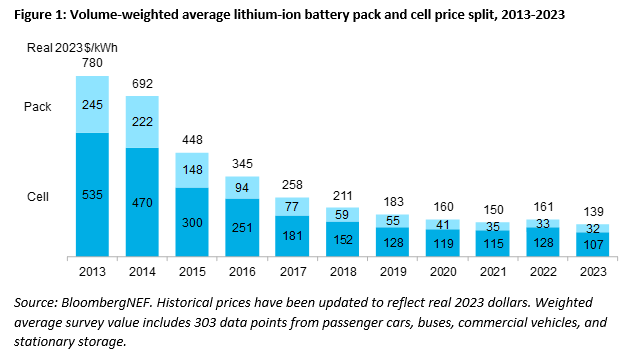Sign up for daily news updates from CleanTechnica on email. Or follow us on Google News!
Thanks to a variety of factors, lithium-ion battery packs are at record low prices. After dropping 14%, they are down to $139/kWh. The steep price drop and record low average price come on the heels of price increases in 2022 that had brought battery prices back to 2020 levels. The world changes fast.
Just looking at EV lithium-ion batteries, the average price for packs was down to $128/kWh, and for cells it was down to $89/kWh.
Production vs. Demand
The figures come from a global analysis by BloombergNEF (BNEF). The reasons for the fast price change are basic economics. Battery pack production increased and battery demand was somewhat lower than expectations, leading to a supply-and-demand imbalance that brought prices down. BNEF emphasizes that it wasn’t just the end production of battery packs that was up, but also production capacity for raw materials and components all across the value chain for batteries.
Of course, EV sales are up, massively, year over year. It’s just that many in the industry expected somewhat faster growth. As is always the case with fast-growing industries, it’s tough trying to perfectly forecast growth in demand and time production increases in an ideal way. But it’s also that push and pull, and resulting price changes, that sometimes stir up faster change.
“The analysis indicates that battery demand across electric vehicles and stationary energy storage is still on track to grow at a remarkable pace of 53% year-on-year, reaching 950 gigawatt-hours in 2023. Despite this growth, major battery manufacturers reported lower utilization rates for their plants, while demand and revenue fell short of many companies’ expectations. As a result, many EV and battery makers revisited their production targets, which in turn impacted battery prices. Lithium prices reached a high point at the end of 2022, but fears that prices would remain high have largely subsided since then and prices are now falling again,” BNEF writes.
“The figures represent an average across multiple battery end-uses, including different types of electric vehicles, buses and stationary storage projects. For battery electric vehicle (BEV) packs, prices were $128/kWh on a volume-weighted average basis in 2023. At the cell level, average prices for BEVs were just $89/kWh. This indicates that on average, cells account for 78% of the total pack price. Over the last four years, the cell-to-pack cost ratio has risen from the traditional 70:30 split. This is partially due to changes to pack design, such as the introduction of cell-to-pack approaches, which have helped reduce costs.”
China vs. US vs. Europe
Unsurprisingly, average battery pack prices were lower in China ($126/kWh) than in the US or Europe. “Packs in the US and Europe were 11% and 20% higher, respectively. Higher prices reflect the relative immaturity of these markets, higher production costs, lower volumes, and the diverse range of applications. There was also intense price competition domestically in China this year as battery manufacturers ramped up production capacity aiming to grab a share of the growing battery demand.”
Europe and the US should see easier price drops as production ramps up more in those markets.
March Into Lithium-Iron-Phosphate Batteries
As we’ve been documenting for years, the electric vehicle industry has shifted more and more to low-cost lithium-iron-phosphate (LFP) batteries — which don’t have as strong of performance as some other EV battery chemistries, but which have gotten good enough energy density and power density at low cost to be the most competitive options in many markets.
“These packs and cells had the lowest global weighted-average prices, at $130/kWh and $95/kWh, respectively. This is the first year that BNEF’s analysis found LFP average cell prices falling below $100/kWh. On average, LFP cells were 32% cheaper than lithium nickel manganese cobalt oxide (NMC) cells in 2023,” BNEF writes.
Forecast: Record Low Battery Prices Again In 2024, 2025, & Beyond
Naturally, the forecast is that the learning curve continues, economies of scale grow, R&D pays off, and lithium-ion battery prices continue to drop. BNEF is expecting record low prices again in 2024, and then record low prices in 2025, and so on and so on. In particular, in 2023 dollars, BNEF is projecting the following battery pack price averages:
- $133/kWh in 2024
- $113/kWh in 2025
- $80/kWh in 2030
At 57.5% the cost of batteries in 2023, one would expect hyper-competitive EV prices in 2030. Disruption mode. And recall that Europe is already at 23% plugin vehicle share (16% BEV share), China is already at 36% plugin vehicle share (24% BEV share), and the world is at 17% plugin vehicle share (12% BEV share). Where will we be in 2030?
Here are some final words from Yayoi Sekine, head of energy storage at BNEF: “Battery prices have been on a rollercoaster over the past two years. Large markets like the US and Europe are building up their local cell manufacturing and we’re keenly watching how production incentives and tightening regulations on critical minerals will impact battery prices. These localization efforts will add a layer of complexity to how battery prices shape up regionally in coming years.”
Have a tip for CleanTechnica? Want to advertise? Want to suggest a guest for our CleanTech Talk podcast? Contact us here.
CleanTechnica Holiday Wish Book
Our Latest EVObsession Video
https://www.youtube.com/watch?v=videoseries
I don’t like paywalls. You don’t like paywalls. Who likes paywalls? Here at CleanTechnica, we implemented a limited paywall for a while, but it always felt wrong — and it was always tough to decide what we should put behind there. In theory, your most exclusive and best content goes behind a paywall. But then fewer people read it!! So, we’ve decided to completely nix paywalls here at CleanTechnica. But…
Thank you!
CleanTechnica uses affiliate links. See our policy here.


